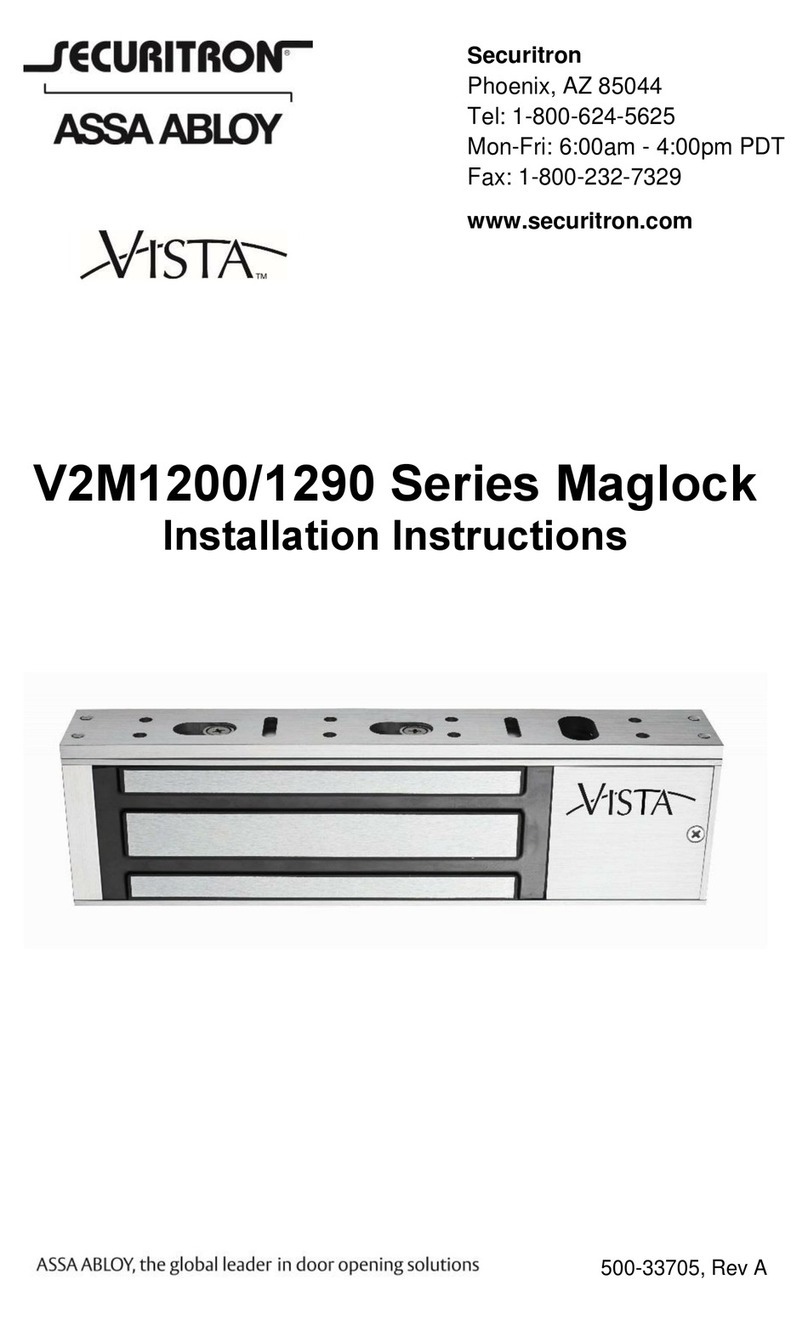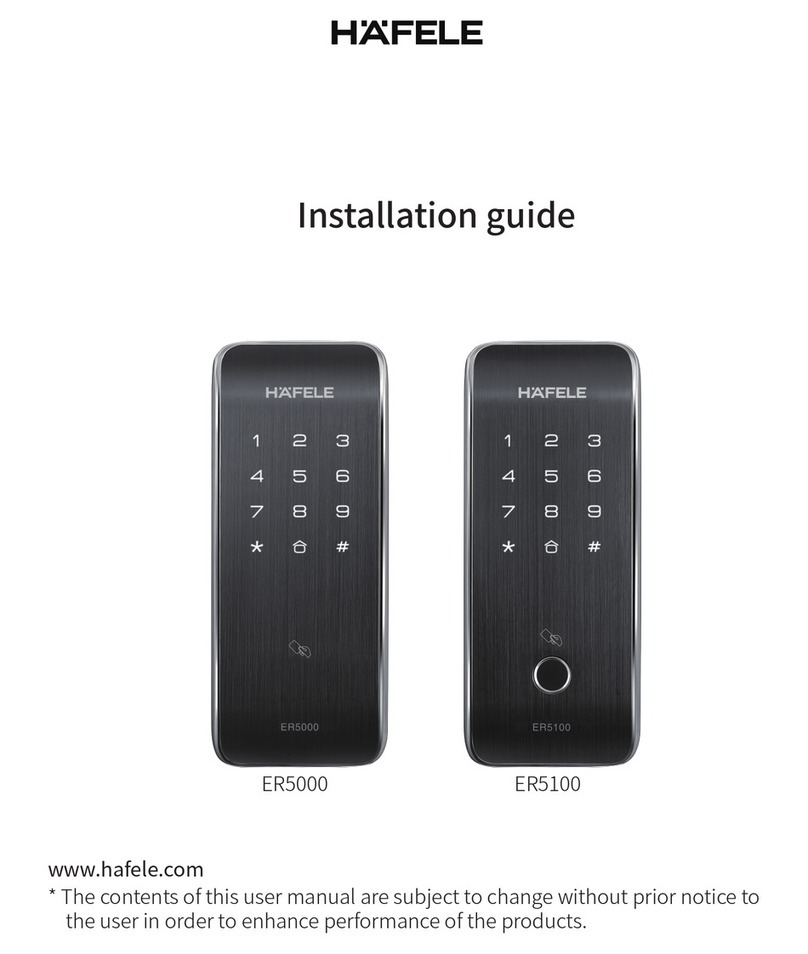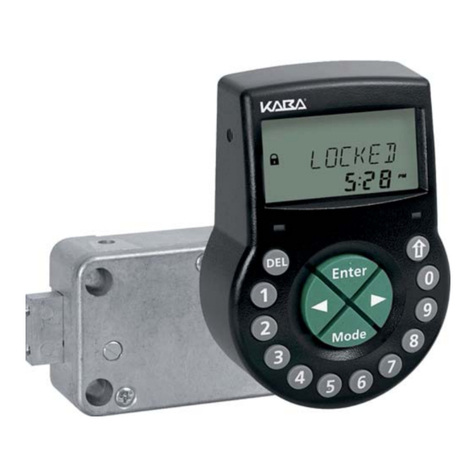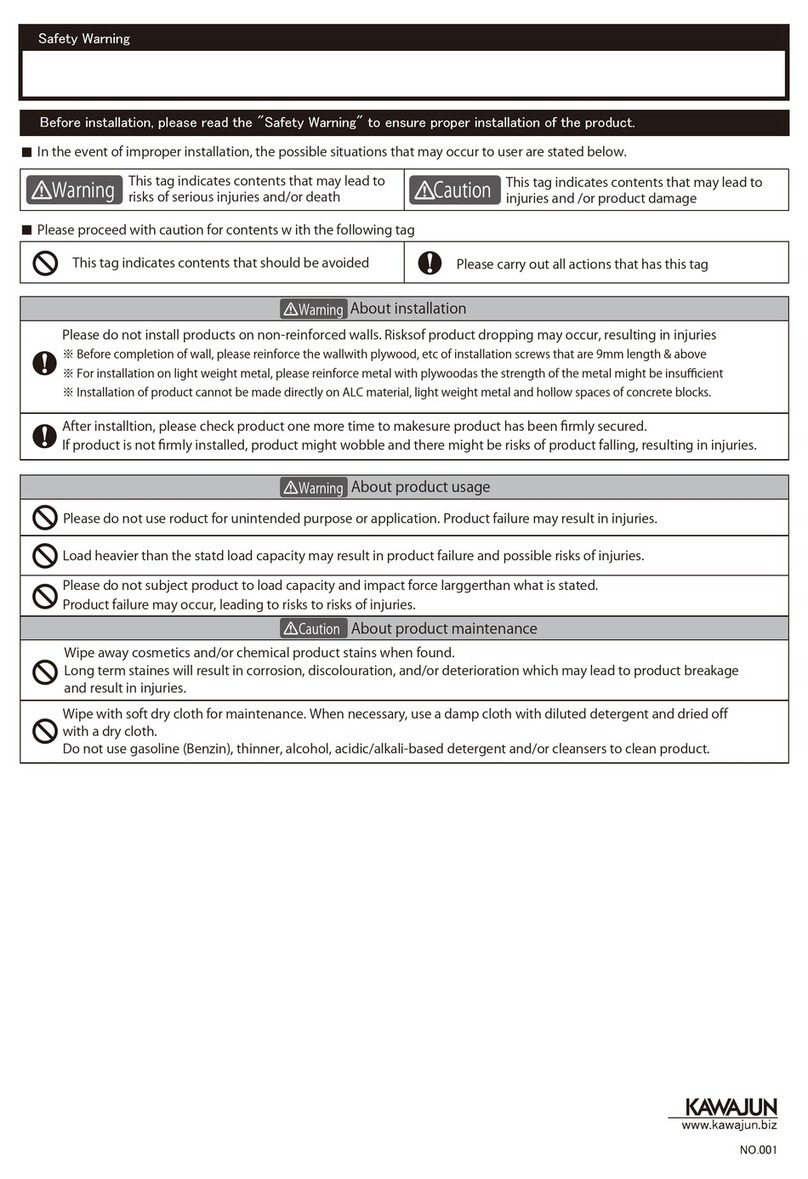Securitron ASSA ABLOY Magnalock DEM680E Series Manual

1 of 12
DEM680E Series Delayed Egress
Magnalock®with EcoMag™Technology
Installation & Operating Instructions
Product Components
A Magnalock & Mounting Bracket
B Strike Housing
C Strike Plate Assembly
D Wall Mounted Key Switch
E Settings Labels
F Sex Bolt & Tapered Washer
G Template Pins
H NFPA Door Label
Installation Hardware Pack Contents
I #14 X 3" Type A Phillips
Pan Head Screw (4)
J Threadlocker Packet
K WOOD DOORS: #6 X
1/2" Phillips Flat Head
Type A Steel Screw (6)
L METAL DOORS: 6-32 X
3/8" Phillips Flat Head
Type F Steel Screw (6)
M #12 X 1-1/2" Type A Phillips
Pan Head Screw (4)
N Rivet Nut Install Tool
O 1/4-20 X 1" Phillips Pan
Head Screw (2)
P 1/4-20 Rivet Nut (2)
Q 3/16" Hex Key
Diagram 1 Product Components
A
C
D
E
FG
H
I
J
K
L
MN
OP
Q
B
Specifications
Dimensions
• Height: 2.50" [64 mm]
• Depth: 2.56" [65 mm]
• Length: 11.50" [292 mm]
Certifications
• UL 10C Fire Rated, 1 Hour
• CAN/ULC-S104 Fire Door Conformant
• UL 294
• UL Tested Ratings: Endurance:
100,000 cycles
• ANSI/BHMA A156.23, Grade
2; E18501 Compliant
• California State Fire Marshal Listed
• NFPA 101
Electrical
• Magnalock Minimum Current Draw
(±10%)
95 mA at 12 VDC
65 mA at 24 VDC
• Magnalock Maximum Current Draw
(±10%)
575 mA at 12 VDC
315 mA at 24 VDC
Static Holding Force
• 1,200 lbs [544kg]
Operating Temperature
• 32˚ to 120˚F [0˚ to 49˚C]
• Indoor use only
NOTE: Hardware is provided for various installations.
There will be leftover parts depending on the type of installation.
IMPORTANT: UL 294 compliance requires that the locking device be powered by a UL
294 (ALVY) or UL 603 (APHV) listed power supply and shall be installed in accordance
with the following UL and National Standards: NFPA 70 – National Electrical Code.
IMPORTANT This Magnalock requires calibration upon installation.

3 of 122 of 12
Performing a
pre-installation survey
1 Before installing the Magnalock, determine and
assess the mounting location for the following:
• Physical strength of the frame — should
be strong enough to meet or exceed the
holding force of the Magnalock.
• Frame and vicinity — should offer protection
for the wiring to prevent vandalism, and provide
adequate protection from rain exposure.
• Door inspection — inspect for any obstacles
that may interfere when mounting the strike
plate and ensure that there is minimum door
movement when the door is latched.
• Proper mounting —The Magnalock comes
with factory default mounting hardware
for use with an out-swing door.
Preparing the Magnalock
1 Ensure that there is at least 2-1/4" between
the closed door and the edge of the header.
If not, a header bracket (sold separately)
may be required (see Diagram 2).
Removing the cover
and mounting bracket
1 Using a Phillips screwdriver, REMOVE the two
(2) screws that secure the cover, as shown in
Diagram 3a, and the (3) screws that secure
the mounting bracket to the top of the
lock chassis as shown in Diagram 3b.
2 SET the cover and screws aside to re-attach later.
3 SLIDE the bracket to disengage from
the top of the lock chassis.
Installing the Magnalock
on a METAL DOOR frame
NOTE: Drilling a pilot hole first or using a step
bit will ensure a snug fit for the blind nuts.
1 DRILL two (2) 3/8" diameter holes in the
frame at the bracket mounting hole marks
(see Diagram 7). DO NOT oversize.
NOTE 1: Blind nuts provide a highly secure and tamper-
resistant system for mounting and are provided for this unit.
NOTE 2: A blind nut installation tool (Securitron BPT-
2, Blind Nut Placement Tool, or similar) can be used
instead of using a box end wrench and hex wrench.
2 INSTALL a blind nut into each 3/8" diameter hole
using the provided tool (see Diagram 8).
• Hold the collapsing nut with a 1/2"
open or box end wrench.
• Maintain pressure against the mounting
surface while tightening the cap screw using a
3/16" hex wrench to collapse the blind nut.
3 DRILL 1/2" diameter wire access holes as needed, on
one or both sides of the bracket (see Diagram 9).
4 REMOVE the protective tape from the frame.
5 Temporarily INSTALL the mounting bracket with
template pins against the closed door using
a Phillips screwdriver and two (2) 1/4-20 x 1"
Phillips pan-head screws (see Diagram 10).
Installing the Magnalock
on a WOOD DOOR frame
1 DRILL two (2) 3/16" diameter mounting
holes by 1-1/4" deep at the bracket-
mounting hole marks (see Diagram 7).
2 DRILL 1/2" diameter wire access holes as needed, on
one or both sides of the bracket (see Diagram 9).
3 REMOVE the protective tape from the frame.
4 Temporarily INSTALL the mounting bracket with
the template pins against the closed door using a
Phillips screwdriver and two (2) #12 x 1-1/2" Type
A, Phillips pan-head screws (see Diagram 10).
Marking the frame
1 PINCH and insert the template pins
flush into the dovetail slots of the
mounting bracket (see Diagram 4).
2 APPLY MASKING TAPE to the door and
frame surfaces to protect from any possible
damage during marking and drilling.
3 PLACE the mounting bracket against the frame stop
on the secure side of the door and on the side of the
door that does not have hinges. Ensure that there
is a minimum a clearance of 1" from the frame.
4 CLOSE the door and adjust the bracket so that
the template pins rest against the door.
5 MARK the frame through the two (2) oblong
(slotted) bracket mounting holes (see Diagram 5).
6 MARK the frame for a wire feed-through hole
at the end closest to where the wire run will be
accessed and ensure the hole marking is centered
at least 5/16” from the end and aligned with the
rear edge of the bracket (see Diagram 6).
7 REMOVE the mounting bracket from the frame.
Diagram 2 Assessing the installation site Diagram 6 Marking the wire feed-through hole
Diagram 7 Drilling the
bracket mounting holes
Diagram 9 Drilling the
wire access holes
Diagram 8 Installing the blind nuts
Diagram 10 Installing the bracket
Diagram 3a Removing the cover
Diagram 4 Inserting
the template pins
Diagram 5 Marking the frame
1-1/8"
Bracket
Mounting
Surface
Anchor Screws
1-11/16" from
door to center
of bracket slots
1/4-20
Blind Nut
AA
2-1/4" from door to trailing
edge of bracket
Diagram 3b Removing
the mounting bracket
1" Min.
5/16"
3/16"

5 of 124 of 12
Diagram 11 Marking the
strike housing mounting hole
locations from the inside
Diagram 13 Securing the plate assembly to the door
Diagram 14 Strike assembly
installed – section view
Diagram 16 Mounting the
Magnalock to the bracket
Diagram 18 Tightening
the mounting screws
Diagram 20 Assembling
the key switch plate
Diagram 22 Installing
the mounting device
Diagram 15 Strike assembly
installed – inside door
Diagram 17 Marking the back
edge of the mounting bracket
Diagram 19 Installing the
final mounting screws
Diagram 21 Marking the wall cut-out
Diagram 23 Installing the key switch
Diagram 12 Drilling the sex
bolt hole from the outside
Installing the strike
on the door
1 With the door closed, ALIGN the strike housing
with the template pins as indicated on the
strike housing. Ensure the strike housing is
pushed up snug against the template pins.
2 MARK seven strike housing mounting
hole locations (see Dia gr am 11).
3 REMOVE the strike housing from the door and the
template pins from the lock mounting bracket.
From the INSIDE
4 DRILL a level 3/8" diameter hole for the
sex bolt all the way through the door at
the strike mounting center mark.
5 FOR A HOLLOW METAL DOOR: DRILL six (6) #36
(0.107") holes through the inside skin of the door for
the strike housing mounting screws.
FOR A WOOD DOOR: DRILL six (6) #36 (0.107)" x 1/2"
deep holes for the strike housing mounting screws.
From the OUTSIDE
6 FOR A HOLLOW METAL DOOR: DRILL out the
3/8" diameter sex bolt hole to 1/2" diameter in the
outside skin of the door (see Diagram 12).
FOR A WOOD DOOR: DRILL out the
3/8" diameter sex bolt hole to 1/2"
diameter completely through door.
Secure the strike plate
assembly to the door
7 INSERT the sex bolt into the hole from the
outside of the door (see Diagram 13).
8 ATTACH the strike plate housing using six (6) 6-32 x
3/8" Phillips flat-head screws for METAL –OR– six (6)
#6 x 1/2" Phillips flat-head screws for WOOD door.
9 CRITICAL STEP: PLACE the tapered washer on the
strike assembly screw with the smaller diameter
surface of the washer facing against the back
of the strike plate, as shown in Diagram 14.
10 APPLY thread-lock compound (included)
to the strike assembly screw.
11 INSERT the strike assembly screw through the
strike housing and door and into the sex bolt.
12 CRITICAL STEP: TIGHTEN the screw into the sex
bolt using the 3/16" hex wrench. While tightening,
gently tap the head of the sex bolt using a rubber
mallet until the head sits flush with the door.
NOTE: To provide maximum door movement after
installation, the head of the strike assembly screw should be
approximately 0.025" (about the thickness of a paperclip)
below the surface of the strike as shown in Diagram 15.
NOTE: DEM680E detects door movement through a concealed
‘patent pending’ strike assembly. OVERTIGHTENING the strike
assembly screw will reduce door movement range and may cause
false alarms. DO NOT OVERTIGHTEN the strike assembly screw.
Mounting the
Magnalock and aligning
to the strike plate
1 SLIDE the Magnalock assembly to fully engage
the lock chassis to the mounting bracket. Install
one of the three screws through one of the top
chassis holes and into the mounting bracket to
temporarily secure the Magnalock (see Diagram 16).
2 SLIDE the lock forward or backward so
that the entire face makes contact with
the strike plate on the closed door.
3 MARK the back edge of the mounting bracket
at each end and remove the Magnalock
from the bracket (see Diagram 17).
4 ENSURE that the mounting bracket
aligns with the marks and TIGHTEN the
mounting screws (see Diagram 18).
5 USING THE BRACKET AS A TEMPLATE, DRILL pilot
holes as necessary, then install and tighten the four
(4) final mounting screws (see Diagram 19).
FOR HOLLOW METAL DOORS: DRILL 3/16" holes and
use #12 x 1-1/2" screws.
FOR WOOD DOORS: DRILL 7/32"
holes and use #14 x 3" screws.
6 RETURN the Magnalock to the bracket and secure
the chassis to the bracket with three (3) screws.
Installing the
wall-mounted switch
1 ASSEMBLE the cylinder and switch to the wall-
mounted key switch plate (see Diagram 20).
2 MARK the corners for the mounting device
at the desired locations on the wall and
create a cut-out (see Diagram 21).
3 INSERT the mounting device into the cut-
out and fasten it in place with a Phillips
screwdriver (see Diagram 22).
4 MAKE the wire connections and install the
key switch plate using a flat-tip screwdriver
and two 6-32 screws (see Diagram 23).
Mark all seven (7) holes
Approximate .025"
Only hand tighten
strike assembly
screw
Strike
Assembly
Screw
Tapered Washer
Orientation
Strike
Plate Sex Bolt
Strike
Housing
Metal Door: 6x 6-32 X 3/8" Self
Tapping Phillips Flat Head Screws
Wood Door: OOv #6 X 1/2" Type
A Phillips Flat Head Screws
STRIKE HOUSING
STRIKE PLATE
STRIKE ASSEMBLY SCREW
3/16" HEX KEY
TAPERED
WASHER
DOOR
SEX BOLT

7 of 126 of 12
H2 (BOND) H3 (DPS) JP3 (EXT INIT)
Table 3 Delayed Egress DIP-switch selection and function
Delayed Egress Function Dip-Switches Position Selection Function/Description Factory Default
Nuisance Delay
SW 1 OFF / SW 2 OFF 0 seconds
Time that the door must be pushed before
triggering the irrevocable alarm cycle. Set
the desired nuisance delay in seconds.
0 seconds
SW 1 ON / SW 2 OFF 1 seconds
SW 1 OFF / SW 2 ON 2 seconds
SW 1 ON / SW 2 ON 3 seconds
Exit Delay
SW 3 OFF 15 seconds Set the desired irrevocable
alarm interval in seconds.
WARNING: a 30 second delay must be
approved by local code enforcement.
15 seconds
SW 3 ON 30 seconds
Bypass Time
SW 4 OFF / SW 5 OFF 0 seconds The expected time for a door closure
after manually bypassing (unlocking)
the system to exit or enter.
Set the desired bypass time in seconds.
0 seconds
SW 4 ON / SW 5 OFF 15 seconds
SW 4 OFF / SW 5 ON 30 seconds
SW 4 ON / SW 5 ON 45 seconds
Post Alarm Reminder
SW 6 OFF Disabled When enabled, provides audible
indication after an alarm event. Disabled
SW 6 ON Enabled
Bypass Expiration
Alarm
SW 7 OFF Disabled When enabled, provides audible indication
when the bypass time has been exceeded. Disabled
SW 7 ON Enabled
Manual/Delayed
Relock
SW 8 OFF Disabled When enabled, the system
automatically relocks 30 seconds
after an irrevocable alarm cycle.
Disabled
SW 8 ON Enabled
Unlocked at Startup
SW 9 OFF Disabled When enabled, system starts
in the unlocked state. Disabled
SW 9 ON Enabled
No Irrevocable
Alarm After Bypass
Expiration
SW 10 OFF Disabled When enabled, prevents irrevocable
alarm after bypass expiration. If SW7
is on, bypass expiration alarm repeats.
If SW7 is off, LED strobe flashes.
Disabled
SW 10 ON Enabled
Table 1 Jumper Settings
Jumpers Position Selection Function/Description Factory Default
H2 (BOND)
1-2 Normally
closed (NC)
Normally closed circuit – opens
when BOND registers secure.
Normally closed
2-3 Normally
open (NO)
Normally open circuit – closes
when BOND registers secure.
H3 (DPS)
1-2 Normally
open (NO)
Normally open circuit
– closes when door opens.
Normally open
2-3 Normally
closed (NC)
Normally closed circuit
– opens when door opens.
JP3 (EXT INIT)
1-2 Disabled When enabled, allows unit to
be initiated from an external
source. (J1, Terminal 4)
Disabled
2-3 Enabled
Table 2 Magnalock DIP-switch selection and function
Magnalock function DIP-switches Position Selection Function/Description Factory Default
LED enable SW 1 ON LED
enabled
When enabled, LEDs
display lock status. ON
SW 1 OFF LED
disabled
(Reserved)
SW 2 – SW 9 N/A Not used. OFF
Reset to Factory Defaults SW 10 OFF Reset
disabled When enabled, restores
Magnalock firmware
to factory settings.
OFF
SW 10 ON Reset
enabled
Diagram 29 Jumper Locations
Diagram 30 DIP-switch Locations
Magnalock Functions
Delayed Egress Functions
Pulling the wiring
NOTE: End-user and installer must comply
with fire and building codes.
1 PULL wires/cables through the wire feed-
through hole(s) drilled in the frame.
2 INSTALL the provided wall-
mounted switch if necessary.
Connecting the
final wiring
1 CONNECT the wires using Diagrams 24
through 28 as guides and as applicable.
NOTE: The positive terminal (+) and reference
voltage (VREF) are internally bussed to provide
a reference voltage for external control.
2 LOCATE the jumpers as shown in Diagram 29.
3 SET the jumpers for the desired
function using Table 1.
4 LOCATE the DIP-switches as
indicated in Diagram 30.
5 Select the desired Magnalock functions
using Table 2 and the desired delay-
egress functions using Table 3.
MAGNALOCK ELECTRICAL INSTALLATION
Diagram 24 Location of J1 and J4 terminals
Diagram 25 Terminal pin-out diagram
Diagram 26 Typical system wiring Diagram 27 Typical system wiring
with external initiate device
Diagram 28 Typical system
wiring with external controls
Terminal Block
Header J4
Terminal Block
Header J1
Door Status
Bond Status
Input
Voltage
External
Controls
External
Alarm
H3
Power
Supply
Wall Mounted
Key Switch
DEM680E
Terminal Block
Header J1
Dry Alarm
Contacts
Power
Supply
External
Initiate
Device
(optional)
Wall Mounted
Key Switch
DEM680E
Terminal Block
Header J1
Dry Alarm
Contacts
Power
Supply
DEM680E
Terminal Block
Header J1
“(+) and ”VREF” Terminals are internally bussed to provide
reference (+) voltage external control use.
Dry Alarm
Contacts

9 of 128 of 12
Reinstalling the cover
NOTE: After wiring, settings, and calibration have been
performed, and the system is functioning properly, the
cover may be reinstalled on the Magnalock.
1 PLACE the cover over the rear of the Magnalock
2 INSTALL the two (2) Phillips screws to
secure the cover (see Diagram 35).
3 APPLY the provided NFPA label with the appropriate
(15 or 30 second) delay designation to the door.
Diagram 35 Reinstalling the cover
Initial calibration
NOTE 1: If calibration does not proceed according to the instructions
below, please see the troubleshooting section at the end of the manual.
NOTE 2: Initial calibration can be performed with a 12-V battery for
installations in facilities that do not yet have commercially-available power.
NOTE 3: Access control systems may register DPS and/or
BOND error conditions during the calibration sequence.
TECH TIP: For installation on a door without a door handle, a pull handle can
be made from masking or other tape to pull the door closed for calibration.
The DEM680E performs an automatic calibration
when the unit is initially powered up. This process only
proceeds if the door is closed and the unit has received
acceptable signals from the DPS and bond sensors.
PERFORM a manual calibration immediately
following installation, if necessary.
1 ENSURE that the door is closed.
2 APPLY power to the Magnalock.
3 PRESS AND RELEASE the calibration button (see Diagram 34).
4 VERIFY that the LED changes from red to amber
to green. The unit is now calibrated.
Calibration Button
Diagram 34 Calibration button
Delayed Egress
status LEDs
The two LEDs shown display the
following Delayed Egress states.
RED GREEN STATE
OFF OFF Unlocked
OFF ON Bypass
ON OFF Egress Alarm
ON ON Locked
Documenting the
configuration settings
1 Indicate the settings on the adhesive-backed labels
included with the Magnalock (see Diagram 32).
2 Complete the labels and affix them to the inside
of the Magnalock cover (see Diagram 33).
Diagram 31 LED location
Diagram 32 System settings
Diagram 33 Settings labels
Behavior of Delayed
Egress Magnalocks with
regional settings
California
Upon power up, lock goes into an alarm state
and requires a manual reset. Nuisance delay
is settable to 0, 1, 2 or 3 seconds and the exit
delay is fixed at 15 or 30 seconds. Bypass delay
is settable to 0, 15, 30 or 45 seconds. A manual
reset is required after a delayed egress event.
Chicago
Upon power up, lock goes into an alarm state and
requires a manual reset. Nuisance delay is fixed at
1 second, the exit delay is fixed at 15 seconds, and
the bypass delay is fixed at 0 seconds. A manual
reset is required after a delayed egress event.

11 of 1210 of 12
Test 1 – Verifying
correct startup
The DEM680E should be calibrated with
a non-zero nuisance delay setting.
1 With the door closed, the LED should be GREEN,
indicating that it is active (see Diagram 36).
• If the LED is RED or AMBER, stop and consult
the Troubleshooting Guide to correct.
Test 2 – Verifying
door security
2 With the door closed, PUSH against the face of
the door WITHOUT releasing the primary locking
mechanism (e.g., an exit device or cylindrical/mortise
door lock). The nuisance alarm should not sound if
the door is adjusted properly (see Diagram 37).
• If the nuisance alarm sounds, there is too much door
movement. The primary locking mechanism must be
adjusted to reduce excessive door travel. Excessive
movement will cause the DEM680E to go into alarm
and unlock when the door is pulled from the unsecure
side. Make necessary corrections and repeat Test 2.
Test 3 – Verify nuisance
alarm function
3 UNLOCK the primary locking mechanism (push bar or turn
handle) and attempt to push the door open. The nuisance
alarm should sound (see Diagram 38). Close the door before
the nuisance interval expires to prevent the alarm state.
• If the nuisance alarm does not sound, the strike
assembly screw may have been overtightened.
Overtightening prevents the door from traveling past
the nuisance threshold. Refer to “No Alarm” in the
Troubleshooting Guide and Diagram 14 which shows
proper adjustment of the strike assembly screw.
Test 4 – Verify countdown
alarm & free egress
4 UNLOCK the primary locking mechanism and attempt to
open the door. The nuisance alarm should sound along
with a flashing strobe. Maintain pressure on the door
until the alarm becomes steady; the DEM680E is now in
alarm state. The door should open in 15 or 30 seconds,
depending on the exit and nuisance delay settings. At
the end of the alarm interval, the LED should turn red,
and the door should freely open. (see Diagram 39).
*After testing, close the door and perform a reset. After
reset, the strobe should turn off and the LED should change
from red to green. VERIFICATION IS COMPLETE.
MAGNALOCK OPERATIONAL TESTS Troubleshooting Guide
TROUBLE INDICATOR POSSIBLE CAUSES POSSIBLE SOLUTIONS
Solid RED
• Two bond sensor failures*
• Supply voltage < 8.5 VDC
• Two bond sensor failures*
• Ensure bond sensor connectors are properly seated
• Check power supply voltage
• Ensure bond connectors are properly seated
Solid RED with
Audible Alarm
• Open door
• DPS failure*
• Attempting to calibrate with two bond sensor failures*
• Strike tray installed upside down
• DPS magnet missing from strike tray
• Close door
• Ensure DPS connector is properly seated
• Ensure bond connectors are properly seated
• Ensure that the strike tray is mounted
with alignment tabs facing up
• Check strike tray for damage, replace if needed
Solid AMBER
• Door sag
• Obstructed strike/magnet face
• Supply voltage < 10.8 VDC
• Single bond sensor failure*
• Magnet disconnected or magnet cable wire broken
• Verify that the strike label has been removed
• Recalibrate
• Check for obstructions between strike and magnet
• Clean face of strike and magnet. Recalibrate
• Check power supply voltage
• Ensure bond connectors are properly seated
• Make sure magnet connector is properly
seated or repair magnet cable wire
Flashing RED • Factory reset • Ensure SW10 is in the OFF position
LED off • LED disabled by SW1
• Supply voltage < 5 VDC
• Turn SW1 to the ON position
• Check power supply
Intermittent alarm
• Over-tightened strike screw
• Unscrew strike screw 1/2 turn at a time
until alarm sound is constant when door
is pushed (Recalibrate lock after each
adjustment and repeat Install Verification)
No alarm
* Failure means that the circut cannot detect a signal from the sensor. Check that the sensor connectors are properly
seated and inspect sensor wires for damage. Call Technical Support if replacement is needed.
Diagram 36 Indicator light displays
Diagram 37
Diagram 39
Diagram 38

12 of 12
techsupport.securitron@assaabloy.com
securitron.com | 800 626 7590
10027 S. 51st Street Phoenix, AZ 85044 USA
Printed in the U.S.A.
Patent pending and/or patent www.assaabloydss.com/patents
Copyright © 2022, Hanchett Entry Systems, Inc., an ASSA ABLOY Group company.
All rights reserved. Reproduction in whole or in part without the express written
permission of Hanchett Entry Systems, Inc. is prohibited. 500-23800_1
Warranty
For information on warranty coverage and replacement options, please visit securitron.com/warranty
Installing the NFPA label
NOTE: Each DEM680E comes with an NFPA exit
delay door label as required by fire code.
1 FOLLOW the included application instructions
to apply the lettering to a door.
Restoring factory
default settings
1 DISCONNECT power from the Magnalock.
2 REMOVE the cover using a Phillips screwdriver.
3 SET DIP-switch 10 (SW 10) to “ON” (see Diagram 40).
NOTE: When power is applied with SW 10 in the ON
position, previous calibration settings are erased. The LED
will continue to flash red until SW 10 is switched OFF.
4 APPLY power to the Magnalock and
verify that the LED flashes red.
5 SET SW 10 to OFF. The unit should auto-calibrate.
If the unit fails to calibrate see Troubleshooting
Guide, or contact technical support.
Diagram 40 Setting DIP-switch 10 to ON
Dip Switch 10 – ON
Table of contents
Other Securitron Lock manuals
Popular Lock manuals by other brands

Canaropa
Canaropa 9500M Series installation instructions
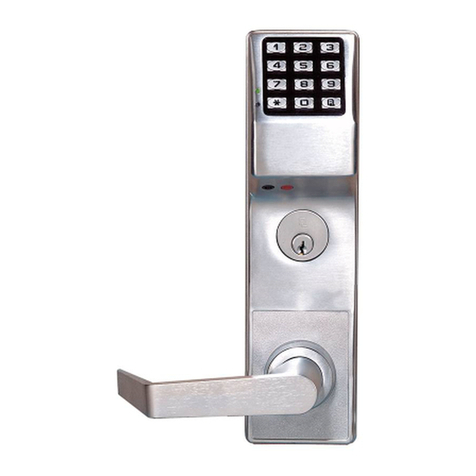
Alarm Lock
Alarm Lock Trilogy DL4100 Series Addendum Programming instructions

Stock Loks
Stock Loks CB-191 instruction sheet
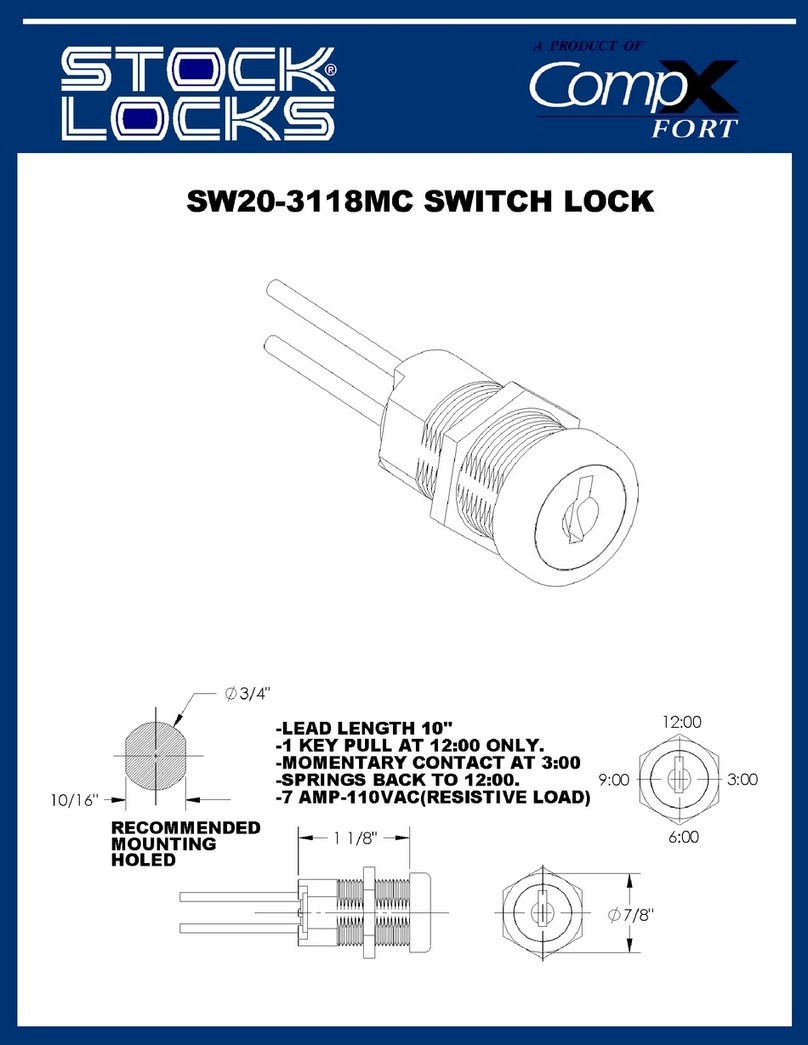
COMPX
COMPX SW20-3118MC Dimensional drawing
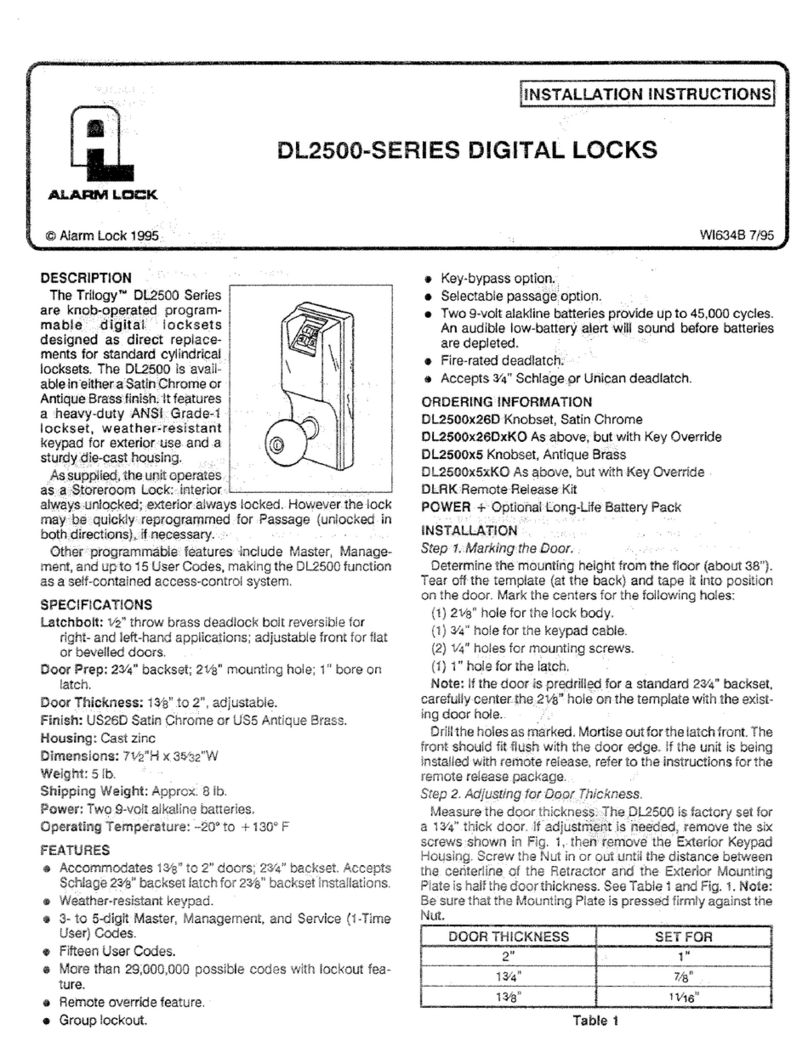
Alarm Lock
Alarm Lock DL2500-SERIES installation instructions
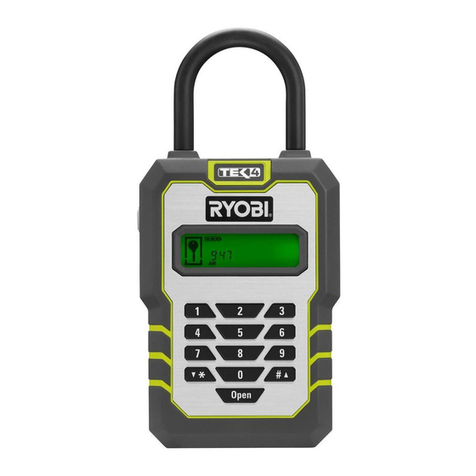
Ryobi
Ryobi RP4310 Operator's manual
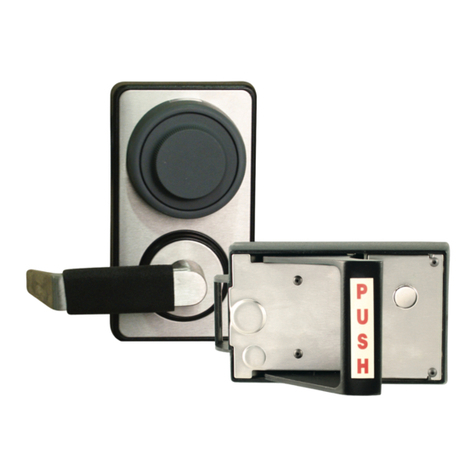
LockMasters
LockMasters LockOne LKM7000 installation instructions
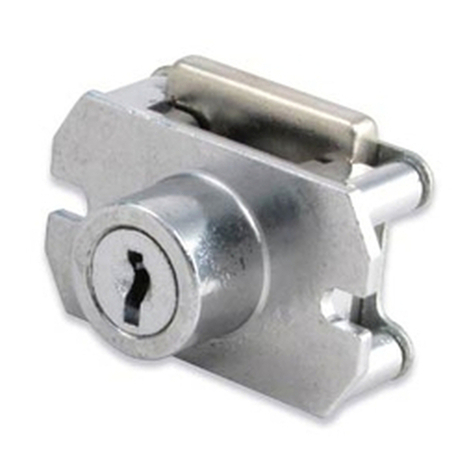
Stock Loks
Stock Loks C8896 instruction sheet
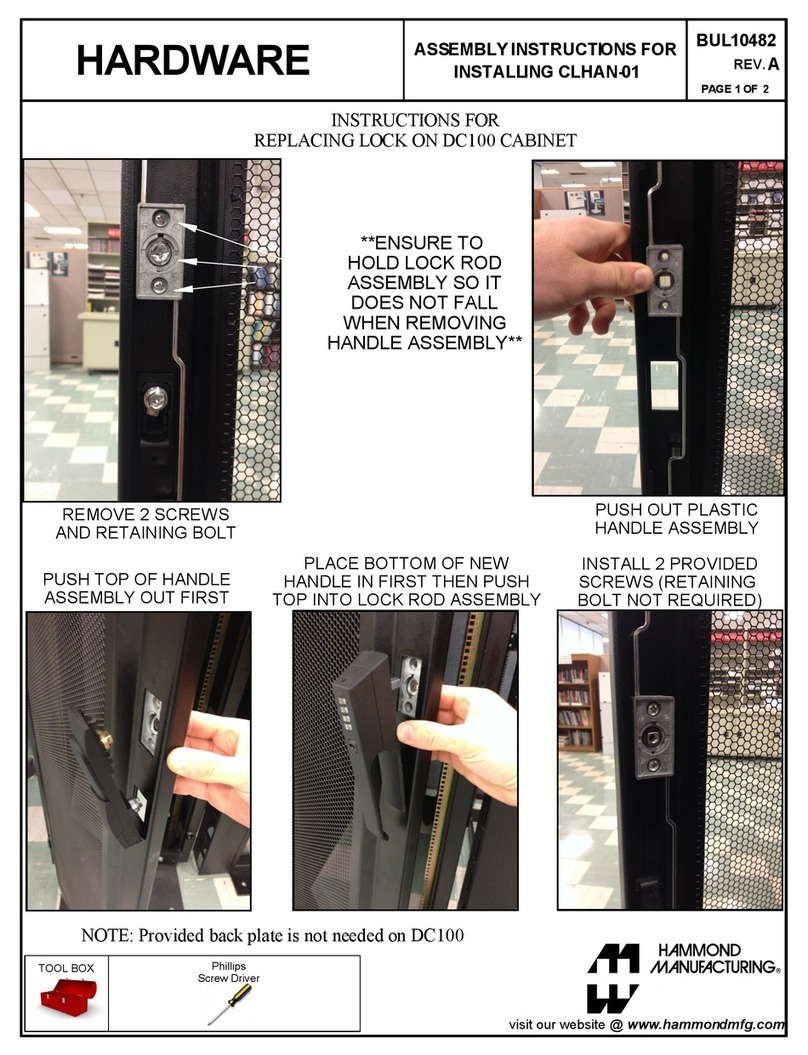
Hammond Manufacturing
Hammond Manufacturing CLHAN-01 Assembly instructions

Schlage
Schlage LINK FE599 user guide
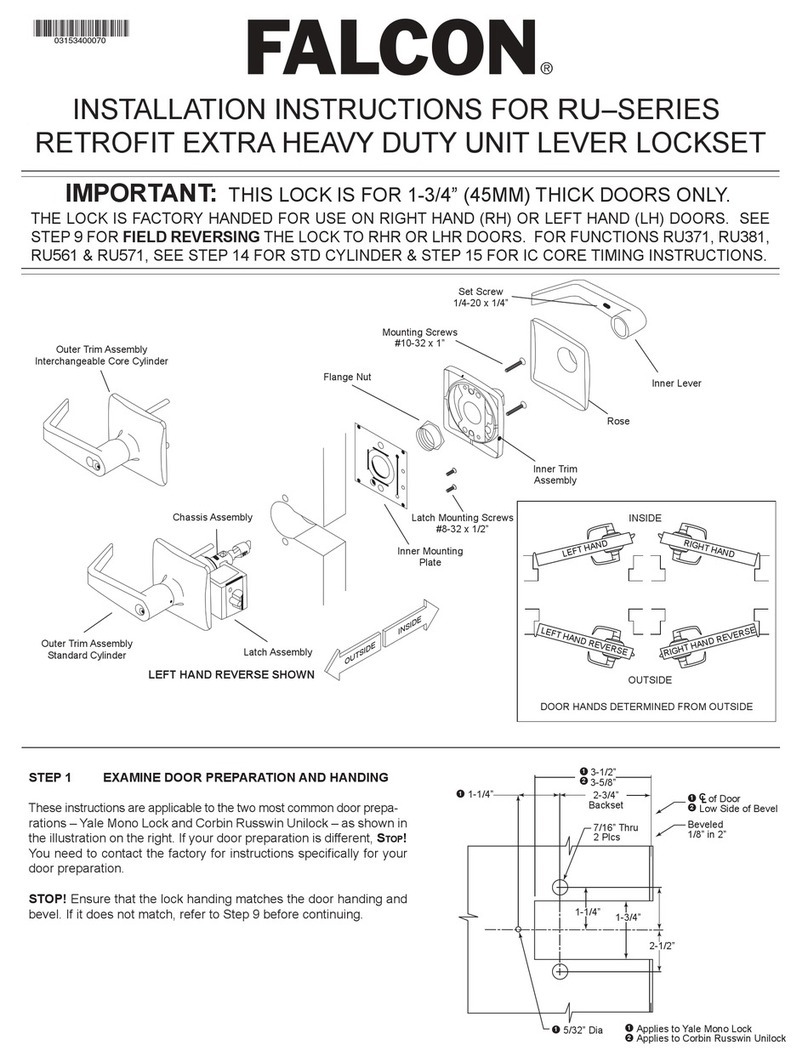
Ingersoll-Rand
Ingersoll-Rand Falcon RU Series installation instructions
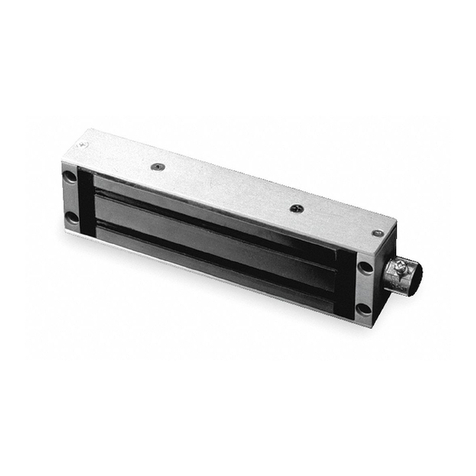
Schlage
Schlage 390G+ installation instructions


